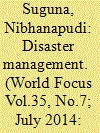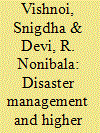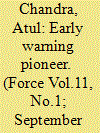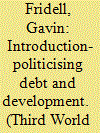|
|
|
Sort Order |
|
|
|
Items / Page
|
|
|
|
|
|
|
| Srl | Item |
| 1 |
ID:
132497


|
|
|
|
|
| Publication |
2014.
|
| Summary/Abstract |
Hundreds of Natural disasters take place worldwide every year causing irreparable damage to life and property. Earthquakes, ?oods, typhoons, hurricanes,- Tsunamis are among the worst of these natural disasters. Over the last few decades, there has been an alarming increase in the occurrence of natural disasters and the magnitude of their social, economic and environmental impact. During any natural disaster it is usually the" children who suffer the most. The nation witnessed the death of nearly a thousand children during the 2001 Bhuj earthquake. Out of them, 300 died while marching for the Republic day parade. They were in a narrow lane when the earthquake hit causing buildings onboth sides to collapse. It is said thatpnearly 1,884 school buildings collapsed leading to a loss of 5,950 class rooms. About 12000 schools suffered damages making them un?t for children to continue their studies. Fire tragedies, like the one in Kurnbakonam killed 93 children in a school. Another ?re accident in Dabwali, Haryana where a ?re broke out during a schoolfunction took he lives of many school children. Children in schools are the 'most vulnerable group during any disaster. These tragedies reiterate the need for all of us to sit up and think about the safety of these children. It is necessary to make schools safe and hazard proof. For this purpose, it is important to have disaster management, emergency preparedness and response plans at school level.
|
|
|
|
|
|
|
|
|
|
|
|
|
|
|
|
| 2 |
ID:
132496


|
|
|
|
|
| Publication |
2014.
|
| Summary/Abstract |
School and higher education has received a very important place in the l2 " Plan document submitted by the working group on disaster management'. There is a paradigm shift in the approach of this document as it has not only earmarked adequate funding for school and higher education, technical education and medical education, but has for the first time tried to use the human resources in a fruitful manner. While the 12"education lists major initiatives which needs to be taken, it has yet to specify the road map for successful. implementation of the recommendations outlining speci?c roles that various stakeholders may play. The Department of Anthropology, University of Delhi, organized a one day seminar to critically examine the document of 12* Five Year Plan with special reference to the 'role of higher education in disaster management.' Ahumble introduction of the chairperson Prof. Vinay Kumar Srivastava, former Principal, Hindu College, and other distinguished speakers, which included Prof. R. B. Singh, Vice President International - Geography Union; Dr. Ranjana Mukhpadhyay, Chairperson, Samutthan Eoundation; Dr Urfat Anjem Mir, Ambedkar University, New Delhi; Dr. Angeli Qwatra, Philanthrope, New Delhi; Dr. Sunita Reddy, Jawaharlal Nehru_University; Prof. V. R. Rao, former Director, Anthropological Survey of India was provided to the audience sharing the expertise and interests of each one of them. Prof. P.C Joshi, Asia Coordinator, EU Integrated Project MICRODIS and President, Society for Indian Medical Anthropology, initiatedthe discussion by sharing the concern of thinking of ways of mainstreaming disaster education at various levels and cadres. It was emphasized to discuss the role and capacities of universities in particular to impart awareness, and support action towards the -same.
|
|
|
|
|
|
|
|
|
|
|
|
|
|
|
|
| 3 |
ID:
125965


|
|
|
|
|
| Publication |
2013.
|
| Summary/Abstract |
Embraer's journey with the Indian Airborne Early Warning & Control (AEW&C) programme began in February 2005, when a Memorandum of Understanding (MoU) was signed between the company and Defence Research and Development Organisation (DRDO), to develop a new AEW&C platform for the Indian Air Force (IAF).
The decision to select EMB 145 Intelligence, Surveillance and Reconnaissance (ISR) platform was taken based on Embraer's experience with the complex systems integration expertise for this class of airborne platform. The contract for three EMB 145 AEW&C platforms was signed in July 2008, the contract including a comprehensive logistics package covering training, technical support, spare parts, and ground support equipment
|
|
|
|
|
|
|
|
|
|
|
|
|
|
|
|
| 4 |
ID:
132671


|
|
|
|
|
| Publication |
2014.
|
| Summary/Abstract |
In the objective of reaching the "nearly zero-energy buildings" target set by the European Union, municipalities cover a crucial role in advocating and implementing energy-efficient measures on a local scale. Based on a dataset of 322 municipalities in Northern Italy, we carried out a statistical analysis to investigate which factors influence the adoption of energy efficiency in municipal buildings. In particular, the analysis focuses on four categories of factors: (i) capacity building for energy efficiency, (ii) existing structure and competences for energy efficiency, (iii) technical and economic support for energy efficiency, and (iv) spill-over effect caused by adoption of "easier" energy-efficient measures. Our results show that capacity building through training courses and technical support provided by energy audits affect positively the adoption of energy efficiency in municipal buildings. The size of the municipal authority, the setting of local energy policies for residential buildings and funding for energy audits are not correlated with energy efficiency in public buildings, where the "plucking of low hanging fruit" often prevails over more cost-effective but long-term strategies. Finally, our results call for the need to promote an efficient knowledge management and a revision of the Stability and Growth Pact.
|
|
|
|
|
|
|
|
|
|
|
|
|
|
|
|
| 5 |
ID:
124216


|
|
|
|
|
| Publication |
2013.
|
| Summary/Abstract |
In contrast to mainstream development economists' and policy makers' insistence that relatively straightforward, technical and apolitical solutions exist to the problems of debt and development, debt is inscribed in powerful, unequal and contested structures and relations. This is vividly depicted in the articles in this special section, written by activists and researchers with years of experience mobilising and supporting grassroots struggles, which reveal the often obscure or unspoken relations of power that underpin the highly unequal dynamics of debt on a global scale, while promoting and offering fresh insights from a diverse array of new initiatives and subversive tactics that confront the dominant debt and development paradigm. They offer sober reflection on what organisations need to do to get things done in continuing and future battles for debt justice.
|
|
|
|
|
|
|
|
|
|
|
|
|
|
|
|
|
|
|
|
|